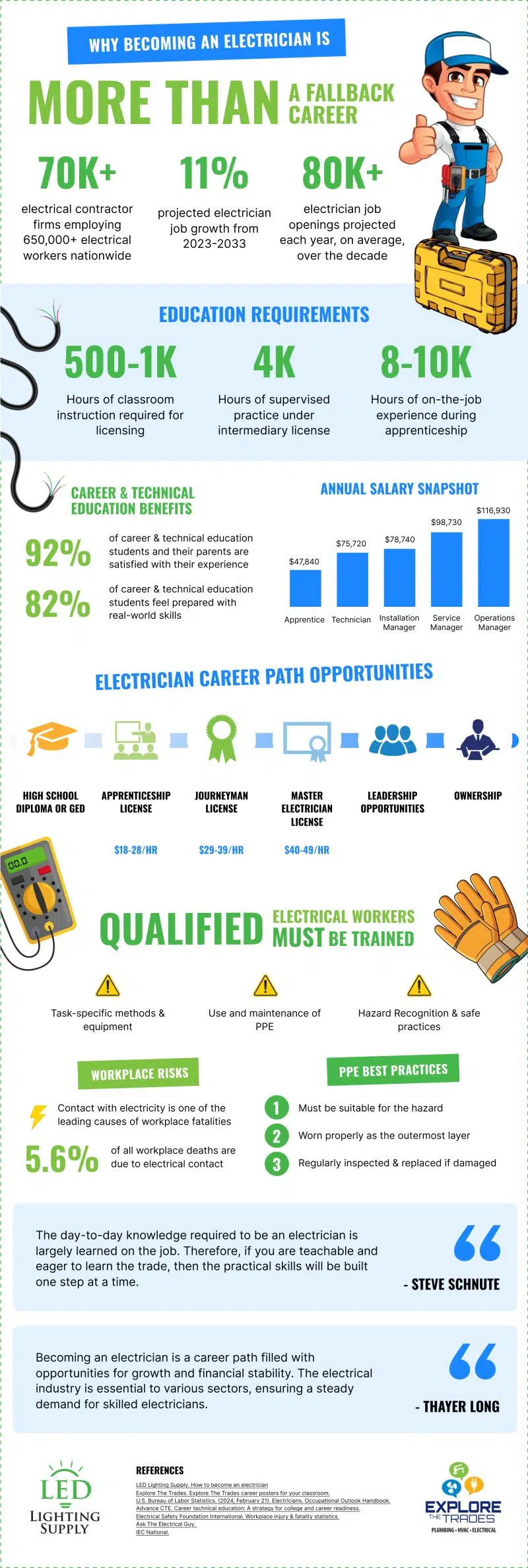Electrician Career Opportunities Surge With 11% Projected Job Growth Through 2033
New Educational Initiative Challenges “Fallback Career” Stigma with Data Showing 11% Job Growth Through 2033 July 23, 2025 – The electrical trades are experiencing a significant transformation, with projected job growth of 11% from 2023 to 2033 far exceeding national averages for all occupations. This growth comes as educational organizations work to reshape perceptions of skilled trades from “fallback careers” to first-choice professional pathways offering competitive electrician salaries and advancement opportunities.
Bridging The Skills Gap Through Education
A new collaborative educational infographic created by LED Lighting Supply and Explore The Trades highlights the reality facing the electrical industry: strong demand coupled with a shortage of qualified professionals. Kate Cinnamo, Executive Director of Explore The Trades, explains the root of this challenge during a recent industry discussion. “When you peel the layers back, and I think everyone wonders, how did we get here? You look at what happened 40 years ago, where in the 70s and 80s, everyone started to go to college, and that sort of started this college for everybody mentality,” said Cinnamo. “The millennials are considered that “lost generation” to the trades because not a lot of people had access to shop class and auto body and all of those classes in school where you would get a dose of that (hands-on education), you would get a taste of what that was like.” 
Career Pathways Offer Multiple Entry Points
The educational initiative demonstrates that electrical careers provide flexible pathways to professional success for various types of electricians, with training options ranging from 500-1,000 hours of classroom instruction to comprehensive apprenticeship programs offering 8,000-10,000 hours of hands-on experience. Career progression opportunities extend well beyond traditional technician roles with residential and commercial electrician salaries ranging from:
- Apprentice positions starting at $18-28 per hour
- Journeyman professionals earning $29-39 per hour
- Master Electrician roles commanding $40-49 per hour
Changing The Conversation About Skilled Trades
The electrician career infographic specifically addresses outdated perceptions that position trades as secondary career options. As Cinnamo notes, “We wanted to dispel that stigma or any stigmas that might be associated with the trades of the old school thinking of well, you just have your toolbox and that’s it, which we know and everybody listening knows that that’s not the case.” The initiative emphasizes that career decisions don’t have to be either-or propositions. I don’t think it has to be an either-or conversation,” Cinnamo explained. “Taking whatever skills you learned in college during the time you were there can easily apply to a new career path.” Cory, reflecting on changing educational approaches, notes: “In the United States, we’ve seen such a push towards you go to high school, you go to college, and that’s the only option. The truth is, yes, you should be a productive member of society, but going to college isn’t the only way to get there.”
Industry Demand Drives Growth Opportunities
The 11% growth projection reflects real-world demand across multiple sectors. Current infrastructure needs, energy efficiency initiatives, and emerging technologies like data centers are creating sustained demand for qualified electrical professionals. Cory Peterson from LED Lighting Supply, who regularly works with contractors and end users, describes the current market reality: “We talk to end users. They want to start work on projects, but they can’t get booked until months and months out because their electrician doesn’t have capacity. Then on the other side, we’ll talk to a contractor who says, I want to do this project. I’m ready to do it. The customer is ready to do it, but I can’t find enough help.” This workforce constraint creates significant opportunities for new electrical professionals entering the field, with demand consistently exceeding available capacity across the industry.
Safety Training Remains Paramount
The educational initiative emphasizes that qualified electrical workers must receive comprehensive training in safety protocols, with electrical contact contributing to 5.6% of all workplace fatalities. Proper training in task-specific methods, equipment usage, and hazard recognition provides essential protection for workers and facilities. Personal protective equipment best practices include ensuring equipment is suitable for specific hazards, wearing proper protective gear as the outermost layer, and regular inspection and replacement of damaged equipment.
Electrician Industry Outlook
With over 70,000 electrical contractor firms nationwide employing more than 650,000 electrical workers, and projections showing 80,000+ job openings annually over the next decade, the electrical industry represents a stable, growing career field for both new graduates and career changers.
